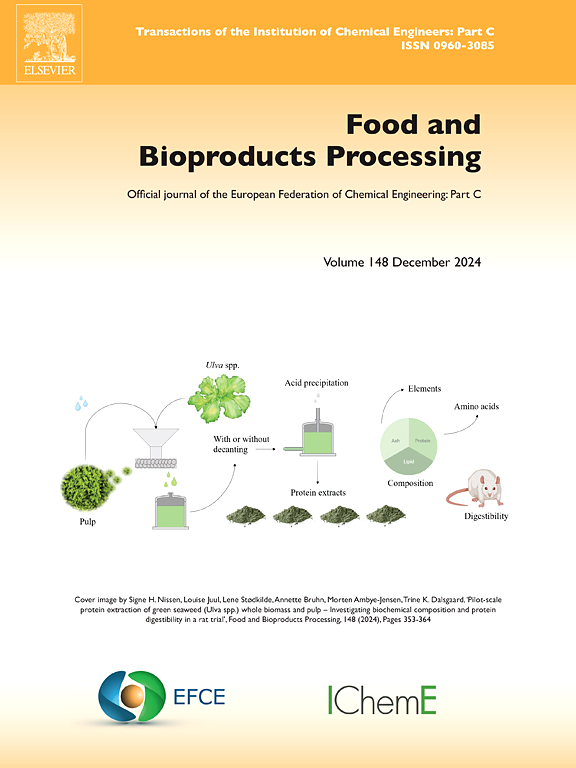Biocompounds recovery from purple corn cob by-product: extraction kinetics, thermal and physicochemical stability of liquid and powdered anthocyanin-rich extract
IF 3.5
2区 农林科学
Q2 BIOTECHNOLOGY & APPLIED MICROBIOLOGY
引用次数: 0
Abstract
This study evaluated the thermal degradation kinetics of total monomeric anthocyanins (TMA) from in-natura purple corn cob and the recovery of bioactive compounds from their by-products. The TMA and antioxidant capacity (AC) extraction kinetics were evaluated by conventional (CE) and ultrasound-assisted extraction (UAE, 25°C, 40 kHz, 32 W/L) methods. The stability of liquid and powdered extract by using maltodextrin (M) [M(2 %)] and corn starch (C) [M(1.5 %) + C(0.5 %)], was evaluated. Thermal degradation kinetics (65–90 °C) showed that TMA are relatively stable at high temperatures, with a half-life of 5.3 h at 90 °C and an activation energy of 949.2 J·mol−1. The TMA and AC extraction kinetics from corn cob by-product, described by the Peleg model, showed that the UAE had the highest extraction rate (<k1) and equilibrium yield (<k2), reducing CE times by up to 58 % and 67 %, for TMA and AC respectively. Furthermore, the stability of this extract was greater at pH ≤ 3, decreasing at neutral and alkaline pH. On the other hand, the water adsorption isotherms modeled by GAB model showed that the powder [M(1.5 %) + C(0.5 %)] had greater stability (Xm = 5.97 g/100 g d.m.) compared to the powder [M(2 %)] (Xm = 3.71 g/100 g d.m.). Additionally, significant differences were observed between treatments in terms of color density, polymeric color, and % tannin contribution, where the powder [M(1.5 %) + C(0.5 %)] demonstrated greater stability. These results highlight the effectiveness of the UAE method for recovering TMA and AC from purple corn cob by-products and the importance of storage conditions and pH in the stability of anthocyanin-rich extracts and powders with potential applications in food and non-food industries.
从紫色玉米芯副产品中回收生物化合物:富含花青素的液体和粉末提取物的提取动力学、热稳定性和理化稳定性
本研究评估了紫色玉米芯中总单体花青素(TMA)的热降解动力学以及从其副产品中回收生物活性化合物的情况。采用常规(CE)和超声辅助萃取(UAE,25°C,40 kHz,32 W/L)方法对 TMA 和抗氧化能力(AC)萃取动力学进行了评估。使用麦芽糊精(M)[M(2 %)]和玉米淀粉(C)[M(1.5 %) + C(0.5%)]对液体和粉末提取物的稳定性进行了评估。热降解动力学(65-90 °C)表明,TMA 在高温下相对稳定,90 °C 时的半衰期为 5.3 h,活化能为 949.2 J-mol-1。用 Peleg 模型描述了玉米芯副产品中 TMA 和 AC 的萃取动力学,结果表明 UAE 的萃取率(<k1)和平衡产率(<k2)最高,TMA 和 AC 的 CE 时间分别缩短了 58% 和 67%。此外,这种提取物的稳定性在 pH 值≤ 3 时更高,在中性和碱性 pH 值时降低。另一方面,用 GAB 模型建立的水吸附等温线表明,与粉末[M(2%)](Xm = 3.71 g/100 g d.m.)相比,粉末[M(1.5 %) + C(0.5 %)]的稳定性更高(Xm = 5.97 g/100 g d.m.)。此外,在色密度、聚合色和单宁成分百分比方面,不同处理之间存在明显差异,其中粉末[M(1.5 %) + C(0.5%)]表现出更高的稳定性。这些结果凸显了阿联酋方法从紫色玉米芯副产品中回收 TMA 和 AC 的有效性,以及储存条件和 pH 值对富含花青素的提取物和粉末稳定性的重要性,这些提取物和粉末在食品和非食品行业具有潜在的应用价值。
本文章由计算机程序翻译,如有差异,请以英文原文为准。
求助全文
约1分钟内获得全文
求助全文
来源期刊

Food and Bioproducts Processing
工程技术-工程:化工
CiteScore
9.70
自引率
4.30%
发文量
115
审稿时长
24 days
期刊介绍:
Official Journal of the European Federation of Chemical Engineering:
Part C
FBP aims to be the principal international journal for publication of high quality, original papers in the branches of engineering and science dedicated to the safe processing of biological products. It is the only journal to exploit the synergy between biotechnology, bioprocessing and food engineering.
Papers showing how research results can be used in engineering design, and accounts of experimental or theoretical research work bringing new perspectives to established principles, highlighting unsolved problems or indicating directions for future research, are particularly welcome. Contributions that deal with new developments in equipment or processes and that can be given quantitative expression are encouraged. The journal is especially interested in papers that extend the boundaries of food and bioproducts processing.
The journal has a strong emphasis on the interface between engineering and food or bioproducts. Papers that are not likely to be published are those:
• Primarily concerned with food formulation
• That use experimental design techniques to obtain response surfaces but gain little insight from them
• That are empirical and ignore established mechanistic models, e.g., empirical drying curves
• That are primarily concerned about sensory evaluation and colour
• Concern the extraction, encapsulation and/or antioxidant activity of a specific biological material without providing insight that could be applied to a similar but different material,
• Containing only chemical analyses of biological materials.
 求助内容:
求助内容: 应助结果提醒方式:
应助结果提醒方式:


